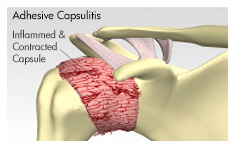There is no known cause for adhesive capsulitis. It can be caused by immunological, inflammatory, biochemical, and hormonal changes. Most notably, adhesive capsulitis increases by approximately 40% when a person develops diabetes. Long-term limitation of movement after suffering a traumatic injury or surgical repair of the shoulder may lead to adhesive capsulitis as well. Typical symptoms include pain and limitation of active and passive shoulder joint movement in all directions (especially abduction and supination). Patients between their 40's and 60's (particularly women) are most vulnerable to adhesive capsulitis.
Stage 1(Painful Stage) - Lasts 3-6 months
Pain radiates from the shoulder across the entire upper arm without any specific traumatic incident to cause the pain. Pain becomes more severe at night, and symptoms become more severe with increased activity.
Stage 2 (Frozen Adhesive Stage) - Lasts 3-18 months
Pain subsides when resting. However, ROM remains limited in all directions. Daily activities are severely limited (e.g. reaching the back pocket, tying hair, etc. are difficult), and pain becomes more acute at night. Moreover, medication or physical therapy is often ineffective in managing pain.
Stage 3 (Thawing Stage)
ROM gradually returns, and recovery can be accelerated with intensive treatment, including exercises, medication, and surgical arthrolysis.
 Shoulder Frozen Shoulder (Adhesive Capsulitis)
Shoulder Frozen Shoulder (Adhesive Capsulitis)
